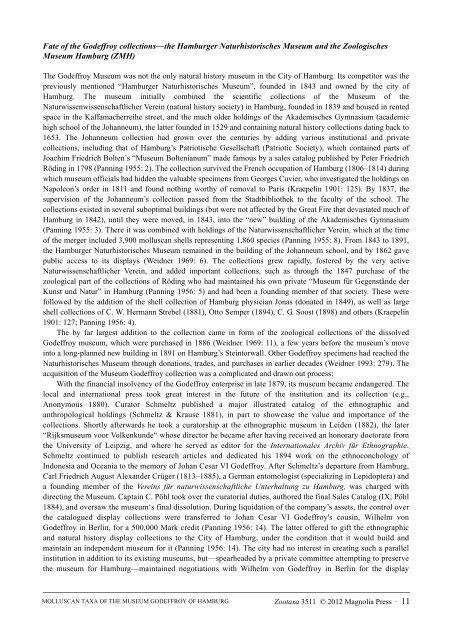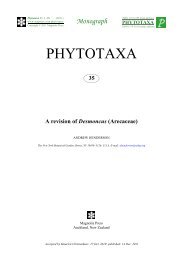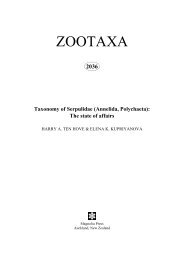You also want an ePaper? Increase the reach of your titles
YUMPU automatically turns print PDFs into web optimized ePapers that Google loves.
Fate of the Godeffroy collections—the Hamburger Naturhistorisches Museum and the Zoologisches<br />
Museum Hamburg (ZMH)<br />
The Godeffroy Museum was not the only natural history museum in the City of Hamburg. Its competitor was the<br />
previously mentioned “Hamburger Naturhistorisches Museum”, founded in 1843 and owned by the city of<br />
Hamburg. The museum initially combined the scientific collections of the Museum of the<br />
Naturwissenwissenschaftlicher Verein (natural history society) in Hamburg, founded in 1839 and housed in rented<br />
space in the Kaffamacherreihe street, and the much older holdings of the Akademisches Gymnasium (academic<br />
high school of the Johanneum), the latter founded in 1529 and containing natural history collections dating back to<br />
1653. The Johanneum collection had grown over the centuries by adding various institutional and private<br />
collections, including that of Hamburg’s Patriotische Gesellschaft (Patriotic Society), which contained parts of<br />
Joachim Friedrich Bolten’s “Museum Boltenianum” made famous by a sales catalog published by Peter Friedrich<br />
Röding in 1798 (Panning 1955: 2). The collection survived the French occupation of Hamburg (1806–1814) during<br />
which museum officials had hidden the valuable specimens from Georges Cuvier, who investigated the holdings on<br />
Napoleon’s order in 1811 and found nothing worthy of removal to Paris (Kraepelin 1901: 125). By 1837, the<br />
supervision of the Johanneum’s collection passed from the Stadtbibliothek to the faculty of the school. The<br />
collections existed in several suboptimal buildings (but were not affected by the Great Fire that devastated much of<br />
Hamburg in 1842), until they were moved, in 1843, into the “new” building of the Akademisches Gymnasium<br />
(Panning 1955: 3). There it was combined with holdings of the Naturwissenschaftlicher Verein, which at the time<br />
of the merger included 3,900 molluscan shells representing 1,860 species (Panning 1955: 8). From 1843 to 1891,<br />
the Hamburger Naturhistorisches Museum remained in the building of the Johanneum school, and by 1862 gave<br />
public access to its displays (Weidner 1969: 6). The collections grew rapidly, fostered by the very active<br />
Naturwissenschaftlicher Verein, and added important collections, such as through the 1847 purchase of the<br />
zoological part of the collections of Röding who had maintained his own private “Museum für Gegenstände der<br />
Kunst und Natur” in Hamburg (Panning 1956: 5) and had been a founding member of that society. These were<br />
followed by the addition of the shell collection of Hamburg physician Jonas (donated in 1849), as well as large<br />
shell collections of C. W. Hermann Strebel (1881), Otto Semper (1894), C. G. Soost (1898) and others (Kraepelin<br />
1901: 127; Panning 1956: 4).<br />
The by far largest addition to the collection came in form of the zoological collections of the dissolved<br />
Godeffroy museum, which were purchased in 1886 (Weidner 1969: 11), a few years before the museum’s move<br />
into a long-planned new building in 1891 on Hamburg’s Steintorwall. Other Godeffroy specimens had reached the<br />
Naturhistorisches Museum through donations, trades, and purchases in earlier decades (Weidner 1993: 279). The<br />
acquisition of the Museum Godeffroy collection was a complicated and drawn out process:<br />
With the financial insolvency of the Godeffroy enterprise in late 1879, its museum became endangered. The<br />
local and international press took great interest in the future of the institution and its collection (e.g.,<br />
Anonymous 1880). Curator Schmeltz published a major illustrated catalog of the ethnographic and<br />
anthropological holdings (Schmeltz & Krause 1881), in part to showcase the value and importance of the<br />
collections. Shortly afterwards he took a curatorship at the ethnographic museum in Leiden (1882), the later<br />
“Rijksmuseum voor Volkenkunde“ whose director he became after having received an honorary doctorate from<br />
the University of Leipzig, and where he served as editor for the Internationales Archiv für Ethnographie.<br />
Schmeltz continued to publish research <strong>article</strong>s and dedicated his 1894 work on the ethnoconchology of<br />
Indonesia and Oceania to the memory of Johan Cesar VI Godeffroy. After Schmeltz’s departure from Hamburg,<br />
Carl Friedrich August Alexander Crüger (1813–1885), a German entomologist (specializing in Lepidoptera) and<br />
a founding member of the Vereins für naturwissenschaftliche Unterhaltung zu Hamburg, was charged with<br />
directing the Museum. Captain C. Pöhl took over the curatorial duties, authored the final Sales Catalog (IX; Pöhl<br />
1884), and oversaw the museum‘s final dissolution. During liquidation of the company’s assets, the control over<br />
the catalogued display collections were transferred to Johan Cesar VI Godeffroy's cousin, Wilhelm von<br />
Godeffroy in Berlin, for a 500,000 Mark credit (Panning 1956: 14). The latter offered to gift the ethnographic<br />
and natural history display collections to the City of Hamburg, under the condition that it would build and<br />
maintain an independent museum for it (Panning 1956: 14). The city had no interest in creating such a parallel<br />
institution in addition to its existing museums, but—spearheaded by a private committee attempting to preserve<br />
the museum for Hamburg—maintained negotiations with Wilhelm von Godeffroy in Berlin for the display<br />
MOLLUSCAN TAXA OF THE MUSEUM GODEFFROY OF HAMBURG<br />
Zootaxa 3511 © 2012 <strong>Magnolia</strong> <strong>Press</strong> · 11
















